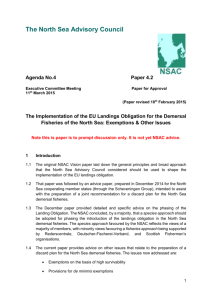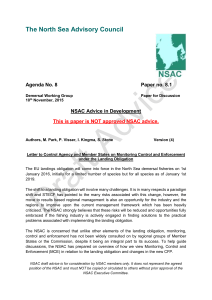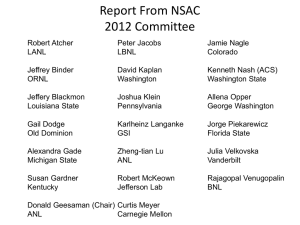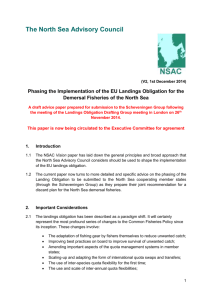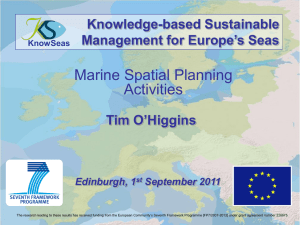Paper 4.2 LO Exemptions (For Disc)
advertisement
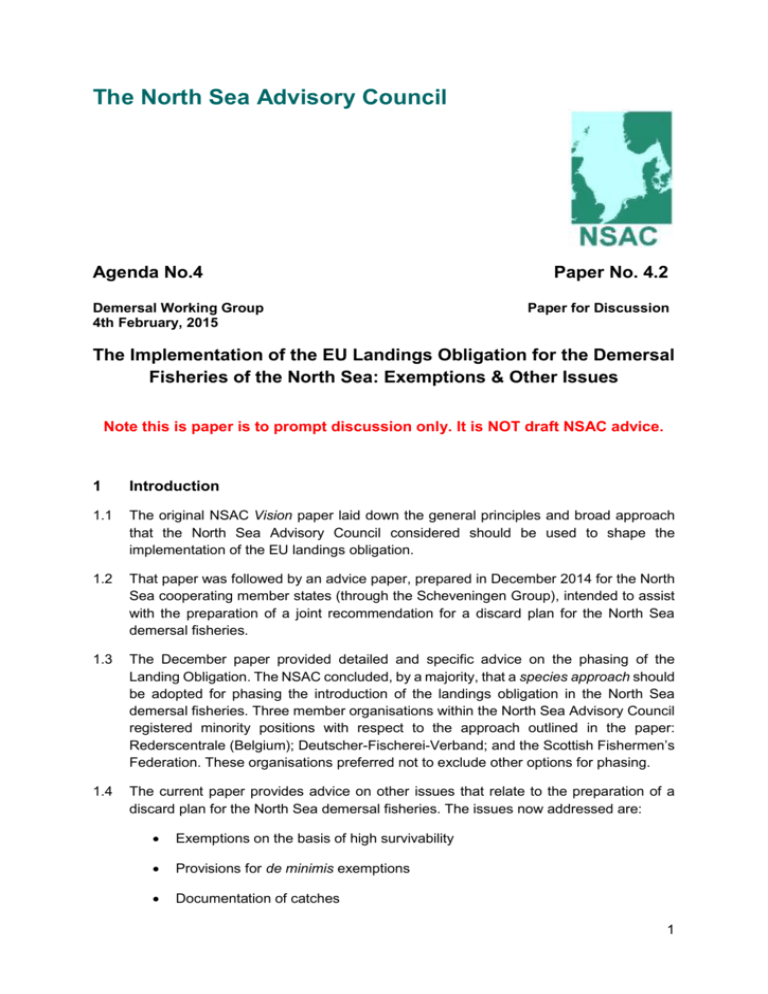
The North Sea Advisory Council Agenda No.4 Demersal Working Group 4th February, 2015 Paper No. 4.2 Paper for Discussion The Implementation of the EU Landings Obligation for the Demersal Fisheries of the North Sea: Exemptions & Other Issues Note this is paper is to prompt discussion only. It is NOT draft NSAC advice. 1 Introduction 1.1 The original NSAC Vision paper laid down the general principles and broad approach that the North Sea Advisory Council considered should be used to shape the implementation of the EU landings obligation. 1.2 That paper was followed by an advice paper, prepared in December 2014 for the North Sea cooperating member states (through the Scheveningen Group), intended to assist with the preparation of a joint recommendation for a discard plan for the North Sea demersal fisheries. 1.3 The December paper provided detailed and specific advice on the phasing of the Landing Obligation. The NSAC concluded, by a majority, that a species approach should be adopted for phasing the introduction of the landings obligation in the North Sea demersal fisheries. Three member organisations within the North Sea Advisory Council registered minority positions with respect to the approach outlined in the paper: Rederscentrale (Belgium); Deutscher-Fischerei-Verband; and the Scottish Fishermen’s Federation. These organisations preferred not to exclude other options for phasing. 1.4 The current paper provides advice on other issues that relate to the preparation of a discard plan for the North Sea demersal fisheries. The issues now addressed are: Exemptions on the basis of high survivability Provisions for de minimis exemptions Documentation of catches 1 Fixing of Minimum Conservation Reference Sizes Identification of potential indicators for future impact assessments 2 Exemptions on the basis of high survivability 2.1 Article 15 paragraph 2(b) of the regulation allows for the possibility of exemptions from the landing obligation for species for which "scientific evidence demonstrates high survival rates". In an expert group report (EWG 13-16) STECF pointed out that there is currently no objective means to define ‘high survival rates’. This is a subjective term and is dependent on the survival rate at age, the age composition of the overall catch, the relative contribution that discards make to total mortality of the stock, and the handling of fish in the fishing gear and on board. ICES scientists have provided some guidance on the conduct of experiments to measure survivability, as clear scientific data are required to enable sound decisions to be taken. 2.2 Earlier research has shown that not all discards of all species die. In some cases, the proportion of discarded fish that survive can be substantial, depending on the species, fishery and other technical, biological and environmental factors. A review of discard survival for STECF has summarised experimentally derived estimates of discard survival rates with respect to species and fisheries/métiers. This has shown, however, that estimates of survival can vary considerably even for the same species. The report emphasises that instead of simply asking, “Can we discard this species?” it may be necessary to ask, “when, where and under what conditions can we discard this species? 2.3 The NSAC recognises that better scientific data are required to enable decisions to be taken on survivability. Many studies are currently underway and are yet to be completed. It may be necessary to delay the introduction of the discard ban for some species in the absence of full evidence on survivability. Where data are lacking the NSAC proposes that the primary guiding principles should be: a) whether exempting fisheries will remove the incentive to reduce discards, which is considered to be the primary objective of Article 15, and b) whether the exemption will result in a significant decrease in fishing mortality; in both the short-term and long-term. Where there is evidence of high survival in a fishery, priority should be given to avoiding any overall increase in fishing mortality. Arriving at the optimum decision should be undertaken case-by-case, taking into account: The conservation status of the stock concerned (with account taken of the survival rate at age, the age composition of the overall catch, and the relative contribution that discards make to total mortality of the stock) Current scientific evidence on survival from that particular fishery The possibility of adequate monitoring and control of any granted exemption The removal of any incentive to avoid unwanted catch, through improved selectivity and other measures, that use of the high survival exemption would bring 2 2.4 2.5 2.6 The need to maintain a level playing field with respect to similar fisheries in different Member States. The process necessary in arriving at a decision will include: A preliminary list of candidate species by gear and by area A filtering/validation process to assess the quality and quantity of information available to inform the decision Initiation of further pilot projects to address any serious data gaps Decisions on any conditionality to be applied to vessels operating in a fishery with a high survival exemption (such as full documentation of catches and discards). The process should: Take into account current scientific opinion, as expressed by ICES and STECF Recognise that current scientific advice on this subject is both patchy and evolving Take into account that a number of pilot projects in the member states are under way and although it would be wise to limit expectations about what these can deliver in the time permitted, equally it will be important to incorporate the lessons learnt into advice when it is available Take into account that the phasing of the landing obligation will either assist or hinder the quality of the information base used for these decisions Recognise that one of the positive features of the landings obligation should be the creation of economic incentives which will encourage vessel operators to reduce unwanted by-catch, to the extent that this is possible. Therefore, in setting exemptions it will be important to strike the right balance between maintaining this incentive and addressing those fisheries where further selectivity is not technically or economically realistic. The NSAC advances the following for preliminary consideration for high survival exemptions: Species potentially eligible for exemption subject to defined conditions, subject to review when further scientific evidence becomes available Gadoids Nephrops Plaice Dab N Y Y Y 3 Sole Anglerfish Lemon sole Turbot Megrim Brill Skates and rays Y Uncertain Y Y Y Y Y Member states have started addressing the data deficiencies through pilot projects from which the first results are expected in the spring of 2015. However, there is currently little information available for anglerfish, skates and rays and little or no research is being done on the survival of these fishes. The NSAC suggests that work on these should begin as soon as possible. 2.7 The position with the gadoid species and some of the prohibited species is quite clear. Survival rates are considered to be generally very low for those species that have swim bladders. With regard to Nephrops and flatfish species, there is a much stronger prima facia argument for exemptions within a case-by-case approach. We therefore advocate exemptions for the latter species, subject to evidence being provided of: Ongoing long-term high survival rates The introduction of fishing protocols to optimise survival rates 2.8 The NSAC does not suggest that it is particularly useful to define “high survival species”, in relation to an arbitrary percentage, above which an exemption would be granted and below which it would not be granted. As the condition of the fish and therefore the prospects for survival are likely to vary both spatially and temporally, it will be necessary to take a number of factors into account. Equally, we currently have little knowledge of the potential for fishing practices to adapt under the landings obligation to increase survival rates through shorter tows, better treatment on deck, faster return to the sea etc. In the past there has been no incentive to develop these features. A more flexible, pragmatic yet science-based process is required to ensure that the exemption process keeps up with emerging knowledge. 2.9 The criteria employed should relate to whether the released fish contribute to the surviving biomass and to what degree. The precepts of good fisheries management should take precedence over a narrow interpretation of the landings obligation. In the Norwegian legislation the rule is that fishers must land dead and dying fish: “all catches must be landed except those capable of surviving”. This decision is left to fishers’ discretion and the rule is not abused. 3 Provisions for de minimis exemptions 3.1 Under the CFP basic regulation up to 5% of total catches may continue to be discarded. The regulation provides for de minimis exemptions of up to 5% of total annual catches of all species subject to the Landing Obligation. The de minimis exemption shall apply in the following cases: 4 Where scientific evidence indicates that increases in selectivity are very difficult to achieve; or To avoid disproportionate costs of handling unwanted catches, for those fishing gears where unwanted catches per fishing gear do not represent more than a certain percentage, to be established in a plan, of total annual catch of that gear. The NSAC emphasises that these are important provisions, and that it will be important for NSAC to be involved in any discussions of de minimis exemptions. It will also be important to ensure that there is a level playing field between fleets in different Member States in applying the exemptions. 3.2 De minimis exemptions will allow continued discarding at sea. It is likely that it will be used sparingly, as any percentage will be deducted from the TAC for that stock at the beginning of the year of application. However, in the situation of mixed fisheries, de minimis may become an important tool to deal with choke stocks. Monitoring of de minimis exemptions will be critical to ensure this flexibility in the CFP is not abused, and does not result in continued overfishing. Monitoring will also help to ensure that all fleets are operating on a level playing field. 3.3 As with high survival exemptions, the NSAC considers that it will be important to put in place an explicit process, to deal with candidate species/fisheries as they arise. De minimis exemptions are perhaps the element of the landings obligation that will be developed most productively through engagement between the NSAC and the Scheveningen Group, taking into account ongoing work within STECF. 3.4 At this stage we envisage that the process of evaluating fisheries for de minimis will require: Initial candidate scenarios for the specific fisheries proposed, supported by evidence to justify the use of de minimis based on the two conditions outlined in Article 15(5)(c) Decisions that follow the best available scientific advice Subsequent monitoring arrangements In drawing up de minimis exemptions it would be sensible to be mindful of STECF’s list of information it considers necessary to judge the merits of a de minimis exemption. 3.5 STECF has suggested that the following information should be presented in the regional discard plans: The management unit in terms of number of vessels; The target species and unwanted by-catch species; The cause and estimate of disproportionate costs; 5 The measures taken to reduce disproportionate costs; Total annual catches by species for the management units; Total levels of unwanted catches; The discard rate; The contribution to the total unwanted catches for all management units. Of primary importance is specifying the actual level of de minimis to be applied and how that is to be implemented/distributed. 3.6 The EWG 13-16 report from STECF highlights that there are a number of interpretational issues relating to the de minimis exemptions described in Article 15. It is unclear whether these exemptions are meant to apply at a Member State level or can be cumulative across Member States. Similarly, it is unclear whether these exemptions should apply at the individual species level or for all species combined (the NSAC interpretation is that it should apply to the individual species). 3.7 There may be a particular problem in defining disproportionate handling costs, which have a bearing on the de minimis exemptions. It is difficult to estimate these costs in advance, but it might be possible to draw up rules for deciding how these costs might be estimated, with advice from STECF. The NSAC would like the Commission to collect further information to support a clearer definition of disproportionate handling costs, and to assist with any decisions that might be made. 3.8 The NSAC is not yet in a position to advise on those species and fisheries to be subject to de minimis provisions. It recognises that decisions on the fisheries and candidate species for de minimis exemptions must be left until decisions have been taken on other issues, including phasing, quota flexibilities and survivability. 4 Documentation of catches 4.1 The Omnibus Regulation deals with some aspects of the recording of catches, but that regulation is not yet agreed. Currently, under the landing obligation all estimated discards above 50 kg live weight must be recorded. A project has been launched by the Control Agency to look at discard recording. Initial studies on the pelagic fisheries will now be extended to the North Sea and North West Waters. The Agency will be working with the Scheveningen Control Experts Group to prepare for the documentation of catches. Documentation of discards is important, but a balance needs to be reached between relevant documentation and full documentation. The NSAC wishes to engage with the Scheveningen Control Experts Group to discuss the documentation of catches. 5 Fixing of Minimum Conservation Reference Sizes 6 5.1 Lists of Minimum Conservation Reference Sizes (MCRS) are being prepared for different areas and fisheries. A starting point is simply to convert Minimum Landing Sizes to MCRS values. Article 15.10 states that “Minimum conservation reference sizes may be established with the aim of ensuring the protection of juveniles of marine organisms”. There is support from the eNGOs for MCRS values to be set as close as possible to the length at maturity, as an incentive to improve avoidance of juveniles. However, the regulation goes further, as Article 15.11 states that “the use of catches of species below the minimum conservation reference size shall be restricted to purposes other than direct human consumption, including fish meal, fish oil, pet food, food additives, pharmaceuticals and cosmetics”. Some fishers have queried whether there is a need to apply the MCRS in this way for marketing purposes, as the fish that have been caught are effectively dead. There is a need to examine more closely why MCRS values need to be set, and on what basis they might be decided. Currently there exist both MCRS and Minimum Landing Sizes and they are set differently. A request will be sent to the Commission from the NSAC asking for a seminar on the setting of MCRS values, to involve all stakeholders. It will need to be a broad forum, including those involved in the sale of fish, and is needed to contribute to a wider discussion on the setting of Minimum Conservation Reference Sizes for the North Sea. Does the setting of an MCRS really contribute to protecting juveniles or is it simply concerned with conserving the value of the catch? Has the Landing Obligation made the setting of Minimum Landing Sizes redundant? 5.2 Currently there is a mismatch between Minimum Landing Sizes for the North Sea and for the Skagerrak/Kattegat. The NSAC supports a Danish suggestion that there should be harmonisation of MCRS values across the North Sea, at the lowest level of the two sizes, unless biological evidence calls for differing sizes. By harmonising the MCRS values the misreporting of catches taken in cross-border fisheries can be avoided. 6 Identification of potential indicators for future impact assessments 6.1 The Landing Obligation is the biggest change in the CFP since its inception. But it has yet to be subjected to any impact assessment. The Commission and some individual Member States may subsequently wish to carry out their own post hoc impact assessments of the Landing Obligation to evaluate whether discards have been reduced and to assess the overall impact of the policy, including impacts on the science base. The NSAC supports the implementation of post hoc impact assessments and will wish to monitor closely the results of any assessments that are carried out. It will be important to establish clear indicators of the success or otherwise of this major change to fisheries legislation. 7
